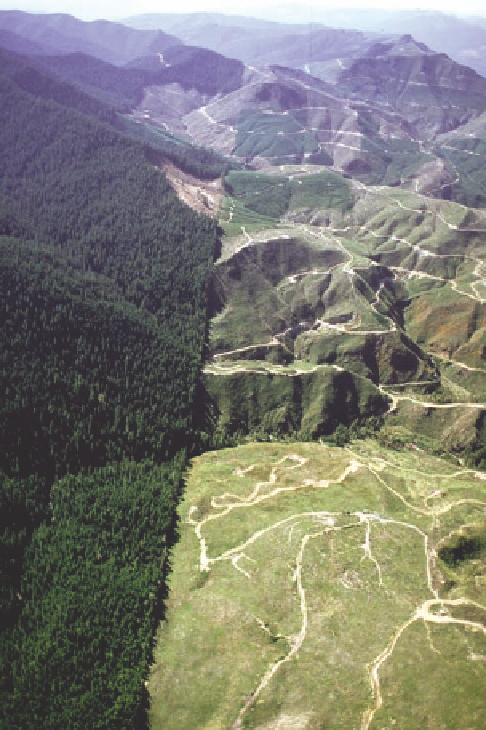Environmental Engineering Reference
In-Depth Information
Deforestation
is the temporary or permanent removal
of large expanses of forest for agriculture or other uses.
Harvesting timber (Figure 8-12) and fuelwood from
forests provides many economic benefits (Figure 8-7,
right). However, deforestation can have many harmful
environmental effects (Figure 8-14, p. 164) that can re-
duce the ecological services provided by forests (Fig-
ure 8-7, left).
If deforestation occurs over a large enough area, it
can cause a region's climate to become hotter and
drier and prevent the regrowth of a forest. Deforesta-
tion can also contribute to projected global warming if
trees are removed faster than they grow back. When
forests are cleared for agriculture or other purposes
and burned, the carbon stored as biomass in the trees
is released into the atmosphere as the greenhouse gas
carbon dioxide (CO
2
).
T rade-Offs
Clear-Cutting Forests
Advantages
Disadvantages
Higher timber
yields
Reduces
biodiversity
Maximum
economic return
in shortest time
Disrupts
ecosystem
processes
Can reforest with
genetically
improved fast-
growing trees
Destroys and
fragments some
wildlife habitats
Short time to
establish new
stand of trees
Leaves moderate
to large openings
Increases soil
erosion
Needs less skill
and planning
Learn more about how deforestation can affect the drainage
of a watershed and disturb its ecosystem at Environmental
ScienceNow.
Increases sediment
water pollution and
flooding when
done on steep
slopes
Best way to
harvest tree
plantations
Good for tree
species needing
full or moderate
sunlight for
growth
Eliminates most
recreational value
for several
decades
Figure 8-13
Trade-offs:
advantages and disadvantages of
clear-cutting forests.
Critical thinking: pick the single advantage
and disadvantage that you think are the most important.
Global Outlook: Extent of Deforestation
Human activities have reduced the earth's forest
cover by 20-50%, and deforestation is continuing at a
fairly rapid rate, except in most temperate forests in
North America and Europe.
Forests are renewable resources as long as the rate of
cutting and degradation does not exceed the rate of re-
growth. There are two pieces of
bad news.
First,
surveys by the World Resources Institute
(WRI) indicate that over the past 8,000 years human
activities have reduced the earth's original forest cover
by 20-50%.
Second,
surveys by the UN Food and Agricultural
Organization (FAO) and the World Resources Institute
(WRI) indicate that the global rate of forest cover loss
during the 1990s was between 0.2% and 0.5% per year,
and at least another 0.1-0.3% of the world's forests
were degraded. If these estimates are correct, the
world's forests are being cleared and degraded at a
Figure 8-12
Natural capital degradation:
clear-cut logging in
Washington state.








